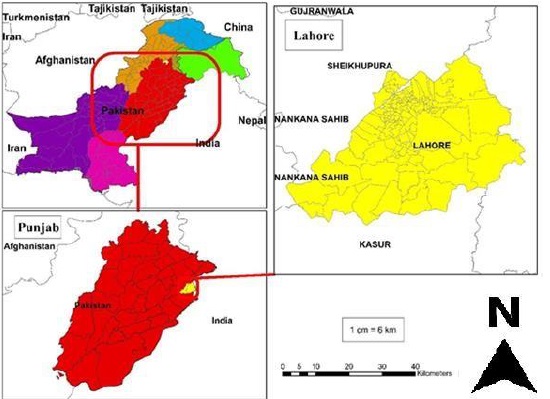Hazardous Effluents and their Impacts on Human Health: Future of Industrial Boom
DOI:
https://doi.org/10.33411/ijist/2020020403Keywords:
Industries, GIS, hazards, human health, urbanization.Abstract
Industries, being commercial productive units perform as manufacturing agents to produce large quantity of goods to cater the needs of increasing population. Manufacturing units use raw material and goods to deliver the final product. The findings of this research are consistent and reliable. The study area mainly consists of three types of industries including iron and steel, chemical and fertilizer and plastic industry. The hazardous waste generated by industries in Pakistan was computed as 1 lac tons per day and more than 10 thousand tons/day in Lahore. These wastes played a vital role in the degradation of environment. In addition, various harmful gases such as fluoride, carbon monoxide and dust were released by these industries which mixed with fog and caused smog that resulted in respiratory diseases and the Lahore remained in smog for last 3 years. The air quality declined to alarming level because of the dust produced by these industries. Air pollution leads to skin problems, and respiratory diseases among residents living in outskirts of these industries. In this research it is estimated that industrial emission is more dangerous than any other emissions. From the year 2008 to 2019 the harmful emissions were categorized as 43% by transport sector, 25% by industries, 20% by agricultural sector and 22% by power sector. Proper planning and management is required to secure the safety of environment from the adverse effects of industries.
References
Aslam, Rana & Amjad, Dania &Kausar, Sumaira& Sarwar, Faiza. (2019). Land cover change analysis and impacts of deforestation on the climate of District Mansehra, Pakistan. Journal of Biodiversity and Environmental Sciences. 14 (6). 103-113. 10.6084/m9.Figureshare.13352873.v1.
Hassan.S.S, Mukhtar.M, Haq.U.H, Aamir.A, Rafique.M.H, Kamran.A, Shah.G, Ali.S and Mahmood.S.A “Additions of Tropospheric Ozone (O3) in Regional Climates (A case study: Saudi Arabia)”. International Journal of Innovations in Science and Technology, Vol 01 Issue 01: pp 33-46, 2019.
Gillani.S.A, Rehman.S, Ahmad.H.H, Rehman.A, Ali.S, Ahmad.A, Junaid.U, and Ateeq.Z.M Appraisal of Urban Heat Island over Gujranwala and its Environmental Impact Assessment using Satellite Imagery (1995-2016). International Journal of Innovations in Science and Technology, Vol 01 Issue 01: pp 1-14, 2019.
Aslam, Rana & Saeed, Urooj & Mehmood, Hammad & Ullah, Hameed & Younas, Imtiyaz. (2017). Impure Water, a Future Disaster: A Case Study of Lahore Ground Water Quality with GIS Techniques.
O'Sullivan, A. and S.M. Sheffrin, 2003. Economics: Principles in Action. 2nd Edn., Upper Saddle River, Pearson Prentice Hall, New Jersey, USA., ISBN-13:9780130630858, Pages: 592.
Imran.R.M, Rehman.A, Khan.M.M, Jamil.M.R, Abbas.U, Mahmood. R.S, and Mahmood.S.A, Ehsan. U.H. Delineation of drainage network and estimation of total discharge using Digital elevation Model (DEM). International Journal of Innovations in Science and Technology, Vol 01 Issue 02: pp 50-61, 2019
B. Steen, A systematic approach to environmental priority strategies in product development (EPS), Version 2000 – Models and Data of the default system, Chalmers University of Technology, Centre for environmental assessment of products and material systems (CPM) Report 1999 (5), Göteborg, 1999.
Saifullah.M, Zafar.M, Sohail.A, Mehmood.F, Musharaf.M, Khan.J, Ashfaq.A and Mahmood.S.A. “Appraisal of Urban Sprawl in Mega Cities of Punjab Pakistan in context of Socio-Political Issues using RS/GIS”. International Journal of Innovations in Science & Technology, Vol 01 Issue 03: pp 108-119, 2019
A.J. Huijbregts, J. Struijs, M. Goedkoop, R. Heijungs, A. Jan Hendriks, D. van de Meent, Human population intake fractions and environmental fate factors of toxic pollutants in life cycle impact assessment, Chemosphere 61 (2005) 1495–1504.
Batool.S.S, Abbas.A, Hussain.I, Wahab, Shafique.A, A, Zaheer.M. “Bacteriological and Physicochemical Analysis of Groundwater of Kasur”. International Journal of Innovations in Science & Technology, Vol 01 Issue 04: pp 151-167, 2019.
M. Hauschild, H. Wenzel, Environmental Assessment of Products. Vol. 2: Scientific Background, Chapman and Hall, London, 1998.
A.J. Huijbregts, J.B. Guinée, L. Reijnders, Priority assessment of toxic substances in life cycle assessment. Part III: Export of potential impacts over time and space, Chemosphere 44 (2001) 59–65.
A.J. Huijbregts, U. Thissen, J.B. Guinée, T. Jager, D. Kalf, D. van de Meent, A.M.J. Ragas, A. Wegener Sleeswijk, L. Reijnders, Priority assessment of toxic substances in life cycle assessment. Part I: Calculation of toxicity potentials for 181 substances with the nested multi-media fate, exposure and effects model ASUS-LCA, Chemosphere 41 (2000) 541–573.
oeller, D. W. (2005). Environmental Health (3rd ed.). Cambridge, MA:Harvard University Press
B. ehera.B and Reddy.VRatna (2002), Environment and Accountability: Impact of industrial Pollution on Rural Communities. Economic and Political Weekly, Vol. 37, No. 3, pp. 257-265
Tahir, Muhammad & Ahmad, Sajid & Aslam, Rana & Ahmad, Israr & Ullah, Hameed & Aziz, Aqsa & Zubair, Muhammad Hamza & Mirza, Ali & Hassan Raza, Dr-Syed. (2020). CRITICAL STUDY OF GROUNDWATER QUALITY OF METROPOLITAN LAHORE USING GEO-SPATIAL TECHNIQUES. 2. 89-105. 10.6084/m9.Figureshare.13352717.v1.
Toxicological Profile for Benzene, Agency of toxic substances and Disease registry (ATSDR), Atlanta, 2007).

Published
How to Cite
Issue
Section
License
Copyright (c) 2020 50Sea

This work is licensed under a Creative Commons Attribution 4.0 International License.




















